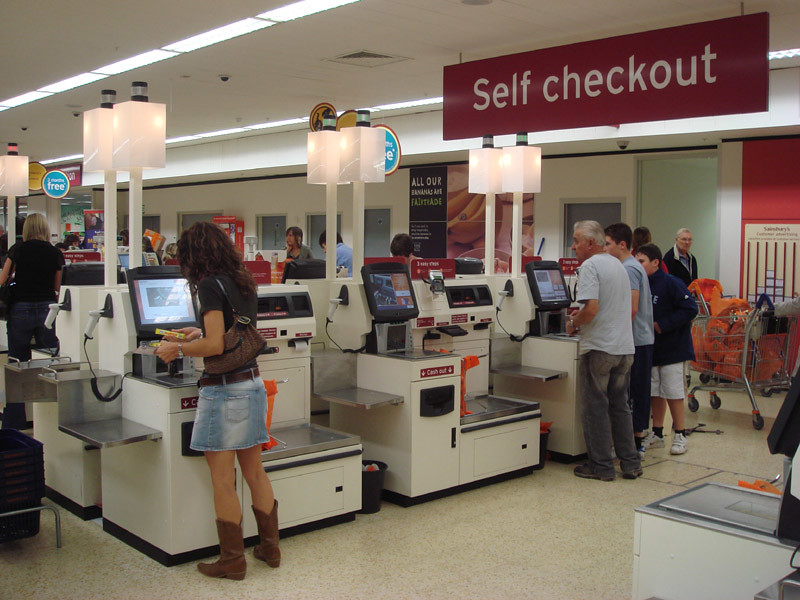
The Explosive Growth of Self-Checkout (Image Credits: Flickr)
Under the fluorescent lights of a bustling supermarket, you scan your last item and wait for that satisfying beep, only to wrestle with a finicky scale or an unexpected error message.
The Explosive Growth of Self-Checkout
Self-checkout kiosks have taken over American grocery stores like wildfire. By 2024, a whopping 96% of them offered this option, and that number keeps climbing into 2025. Stores from coast to coast are ditching traditional lanes to make room for these machines.
It’s all driven by tech advancements and the push for efficiency. Retailers see it as a way to cut costs and speed up lines during peak hours. Yet, as more shoppers encounter these setups daily, the initial excitement is fading fast.
Recent reports highlight how chains like Walmart and Whole Foods are expanding their self-service areas, sometimes making them the only choice available.
What Draws People to Self-Checkout
For some, self-checkout feels like a breath of fresh air. No more waiting behind someone debating coupons or unloading a massive cart slowly. You grab your items, scan them quick, and head out – done in minutes.
Privacy plays a role too. Introverted shoppers appreciate skipping small talk with cashiers. Plus, contactless payments make it seamless, especially post-pandemic when everyone got used to keeping distance.
Early adopters rave about the empowerment. It’s like having control over your own checkout speed, turning a chore into something almost fun.
The Hidden Hassles That Frustrate Everyone
However, not everyone shares that enthusiasm. Common glitches top the complaint list: items that won’t scan, bags that trigger alarms, or screens freezing mid-transaction. Suddenly, your quick trip turns into a tech support call.
Receipt checks at the door add insult to injury. Shoppers bag their own groceries, pay up, and then face scrutiny like potential thieves. This extra step feels invasive and slows things down again.
Space issues compound the problem. Tiny platforms for bagging mean juggling produce and bags awkwardly, especially for families or those with mobility challenges.
Pros and Cons at a Glance
To break it down simply, self-checkout has clear upsides and downsides. Here’s a quick look:
- Speed for light shoppers: Ideal for a few items, cutting wait times.
- Cost savings for stores: Fewer staff needed, boosting profits.
- Tech glitches: Frequent errors that demand intervention anyway.
- Job impacts: Reduces cashier roles, hitting entry-level employment.
- Equity issues: Harder for elderly or non-tech-savvy folks.
- Theft concerns: Easier for some to skip scans, leading to more checks.
How Stores Justify the Shift
Grocery chains argue self-checkout modernizes shopping. They point to data showing faster throughput during busy times, like evenings or weekends. Automation also frees employees for stocking shelves or helping with questions.
Behind the scenes, investments in AI and better software aim to iron out kinks. Some stores even offer hybrid models, blending self-service with on-call help to ease transitions.
Still, backlash is real. A few retailers, inspired by customer feedback, are experimenting with pulling back – adding more human lanes to regain trust.
Looking Ahead: 2025 and Beyond
As we head deeper into 2025, trends suggest even more integration. Market reports forecast the self-service kiosk industry growing at over 6% annually, fueled by retail automation. Expect smarter machines with facial recognition or app integrations to pop up.
Customer opinions remain split, though. Social media buzz shows a push for balance – keep the option, but don’t force it. Stores ignoring this risk losing loyal shoppers to competitors with better service.
Innovation could tip the scales. Imagine kiosks that actually assist, like suggesting recipes from your cart or handling produce weighing automatically.
Key Takeaways
- Self-checkout boosts efficiency but often at the cost of user frustration.
- 96% adoption rate means it’s here to stay, yet hybrid approaches may win out.
- Shopper voices matter – stores adapting to feedback will thrive.
In the end, self-checkout boils down to choice: a tool for convenience when it works, but a headache when it doesn’t. The real winner? Stores that listen to their customers and blend tech with the human touch. What’s your take on self-checkout – lifesaver or nightmare? Share in the comments below.



